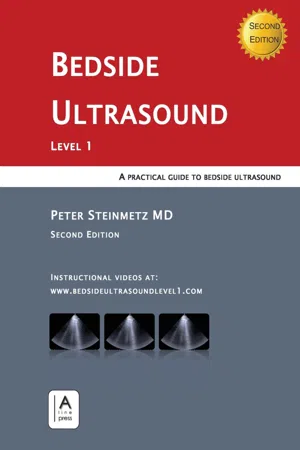
- English
- ePUB (mobile friendly)
- Available on iOS & Android
About this book
The second edition of this textbook offers expanded chapters with additional ultrasound images, videos, and text. Thetextbook is a beginner book for healthcare workers starting to apply bedside ultrasound in their daily practice. The book has received outstanding reviews from medical students, residents, and physicians clinicians. Over 1300copies have been sold worldwide. Clear diagrams, ultrasound images, and instructional videos help to illustrate the concepts outlined in the text. No prior experience in bedside ultrasound is necessary. Chapters 1-3 address the basics of ultrasound. Chapters 4-11 address different applications for bedside ultrasound. Troubleshooting tips, false-positives and negatives, and documentation guidelines are provided at the end of the chapters. And index and full bibliographic references complete the book.
Frequently asked questions
- Essential is ideal for learners and professionals who enjoy exploring a wide range of subjects. Access the Essential Library with 800,000+ trusted titles and best-sellers across business, personal growth, and the humanities. Includes unlimited reading time and Standard Read Aloud voice.
- Complete: Perfect for advanced learners and researchers needing full, unrestricted access. Unlock 1.4M+ books across hundreds of subjects, including academic and specialized titles. The Complete Plan also includes advanced features like Premium Read Aloud and Research Assistant.
Please note we cannot support devices running on iOS 13 and Android 7 or earlier. Learn more about using the app.
Information


| Hyperechoic: | Bone appears hyperechoic (white) on the ultrasound image. Its high-density and the interface between surrounding structures of lower density cause a high degree of reflection. |
| Hypoechoic: | Muscle and liver appear hypoechoic (grey) on the ultrasound image due to their moderate density. |
| Anechoic: | Fluid (blood, ascites, pleural effusions) appears anechoic (black) on the ultrasound image. This is because ultrasound travels through low-density structures with minimal attenuation and reflection back to the ultrasound probe. |



Table of contents
- Cover
- Title Page
- Copyright Page
- Preface
- Dedication
- About the Author
- Acknowledgements
- Contents
- 1. Ultrasound Basics
- 2. Image Generation
- 3. Image Artifacts
- 4. Dyspnea
- 5. Undifferentiated Hypotension
- 6. Trauma
- 7. Abdominal Aortic Aneurysm (AAA)
- 8. Cholecystitis
- 9. Kidney Injury
- 10. Deep Venous Thrombosis (DVT) of the Lower Limb
- 11. Ectopic Pregnancy
- Index
- References